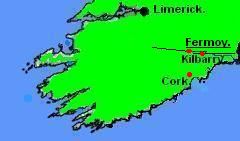|
|
|



|
The photograph of this sketch was published in the "Sunday Press" on 15th.February 1953  L-R front row: P. Brennan, General Lucas, Joe Keane, L-R back row: Paddy Brennan and Michael Brennan. a British Army General, Brigadier General Lucas. A sensational and dramatic event took place on the banks of the River Blackwater on June 26, 1920, that was to become part of Cork's History. On that day Brigadier General Cuthbert Henry Tyndall Lucas was abducted by Liam Lynch. It was a calm, sunny morning as General Lucas and his entourage left the British Military Barracks in Fermoy. They were heading for Kilbarry, which lies four miles east of Fermoy, for a day's salmon fishing.  The three tackled up their rods and split up, looking forward to a peaceful day by the river. But back in Fermoy, preparations were already under way for one of the most daring events of the War of Independence. Scouts who were posted on the banks of the river reported back to Lynch and a decision was taken to capture Lucas. The capture of such a senior British officer would be a serious blow to the British military presence in Ireland. Together with George Power, Sean Moylan and Patrick Clancy, Lynch set off for Kilbarry. Given the fact that Fermoy was then a Garrison Town occupied by thousands of British troops, the plot to kidnap such a senior officer was riddled with danger. But Lynch had planned the operation to the last detail. Arriving at Kilbarry, his group overpowered Lucas's personal servant and took up occupation of the fishing hut on the south bank of the river. There they waited patiently until evening. In the meantime, the three British officers were enjoying their fishing, little thinking that their day by the banks of the Blackwater would have such drastic consequences.  All three men were taken to the fishing hut where Lynch informed them that they were being held as prisoners of war. Lucas's personal servant was released and sent back to Fermoy Barracks with a letter informing the British of the capture of the three officers.  A general alarm was sounded and hundreds of troops scoured the countryside in search of their General. Spotter planes from Fermoy Aerodrome flew over the Blackwater Valley, but Lynch and his prisoners were already racing to a safe haven near Mourneabbey. However, the captives were not going to give up without a struggle and after a conversation in Arabic, they attempted to take control of the car in which they were being transported. The car crashed and a fierce fight took place in which Danford was wounded. It says much for the character of Liam Lynch, that Tyrell was released to look after his comrade and that the services of a doctor were sought. Having spent over a month as a captive in various locations in Counties Cork and Limerick, and having being treated with every respect and consideration, General Lucas escaped from his escort on July 30 1920 and made his way back to his own forces. In a statement in the Daily Mail Newspaper some days later, General Lucas said he had been treated honourably, as a soldier, by soldiers. The same cannot be said of his soldiers who took revenge on the town of Fermoy. On June 28, in an orgy of looting and destruction, shops and private houses were set ablaze. This was the second occasion on which the town of Fermoy had been burned by drunken British troops in the same year. Tension remained high in the town and troops were further infuriated by being taunted by youths singing a song , Can Anybody Tell Me Where Did General Lucas Go, a ribald version of the Blarney Roses. On April 10, 1923 Liam Lynch was shot on the Knockmealdown Mountains. At 8.45pm that evening he died in St.Joseph's Hospital in Clonmel. He now lies buried with his old comrade, Mick Fitzgerald in Kilcrumper Cemetery. Today at Kilbarry, all is peaceful and quiet, as the river flows silently by. On the north bank the ancient burial ground of the Grant family stands like a sentinal overlooking Kilbarry, where Liam Lynch entered Irish legend in June 1920.
|

